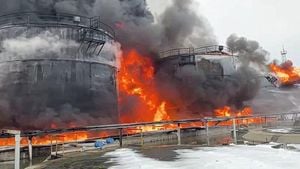NASA faces urgent concerns as the Boeing Starliner spacecraft malfunctions, putting the safety of astronauts Sunita Williams and Butch Wilmore at risk. They are currently aboard the International Space Station (ISS) via Starliner, which has faced significant delays during its development.
NASA's plans for Starliner involve using the spacecraft to transport astronauts to and from the ISS, enhancing the accessibility of human spaceflight. Since its inception, Starliner has experienced multiple setbacks, with safety and reliability being persistent concerns.
The astronauts may be left stranded with only 96 hours of breathable oxygen if they cannot return to Earth soon. They also risk facing dire consequences if the spacecraft does not succeed during re-entry.
Boeing's Starliner makeup includes complex systems for life support and navigation, which are intended to minimize risks during missions. Engineers are working around the clock to address and rectify current malfunction issues to enable their return.
Failure to re-enter properly could lead to catastrophic outcomes. Williams and Wilmore might face the threat of vaporization should the spacecraft enter the atmosphere at too steep of an angle, creating immense heat stress on the vehicle.
Experts, like former military space system commander Rudy Ridolfi, have laid out possible scenarios for how the astronauts might make their way home safely. The wanted solution is for Starliner to execute its return maneuver as planned, but the risks remain pronounced.
Another potential scenario involves becoming stranded indefinitely, floating endlessly if re-entry is unsuccessful. If this situation occurs, they would have to rely on limited resources onboard.
The astronauts currently utilize life support systems, and with only three days left of oxygen supply, the urgency mounts. Consequently, many are left to contemplate the most pressing question: how can NASA secure their safe return?
Sunita Williams and Butch Wilmore are two seasoned astronauts with extensive training, yet they find themselves facing unprecedented circumstances. NASA's response involves leveraging their experience, but the situation is undeniably perilous.
This is not the first time Boeing has faced criticism over the safety of Starliner. Previously, issues with the spacecraft's software and numerous test delays raised alarms within the space community.
Space exploration inherently involves high risks, and safety protocols must be stringent to prevent mishaps. NASA and Boeing must reinforce these protocols as they continue to iron out logistical and technical issues surrounding Starliner.
The pressure is palpable as agencies work to resolve this crisis and prioritize astronaut safety as topmost importance. With only minimal oxygen left and the risk of overheating during re-entry, every move by mission control is under scrutiny.
This predicament poses significant questions about the future of space exploration and reliability of crewed space vehicles. Solutions must be sought before astronauts find themselves stranded beyond terrestrial reach.
Currently, contingency plans are under review, including potential maneuvers to extend the astronauts' stay on the ISS if needed. Fortunately, the current conditions of the space station can accommodate their extended presence for the time being.
Monitoring for radiation and muscle loss due to prolonged weightlessness also adds complexity to their mission. Astronauts like Williams and Wilmore undergo physical and psychological assessments to safeguard their health amid these risky situations.
While the future remains uncertain, experts remain hopeful for resolution as they monitor the Starliner progress. Boeing's Starliner has much at stake beyond the immediate safety of its crew.
Officials maintain communication with the astronauts, ensuring they have access to real-time data as they await updates. The need to prioritize health and well-being remains evident amid the technical uncertainties.
NASA is also exploring alternative options to regain complete control of the situation surrounding the Starliner. They plan to develop clear strategies for subsequent missions should they encounter additional setbacks.
Technical experts have been deployed to identify the source of the issues, ensuring information is gathered quickly for swift action. If the spacecraft can resume standard operations, the chances of securing the safe return of the astronauts improve significantly.
The increasing reliance on commercial space vehicles adds layers of complexity to NASA's partnerships. This includes Boeing, whose accountability remains pivotal as they work diligently to resolve issues jeopardizing astronaut safety.
Hope exists for mission success through close collaboration and innovation to overcome these challenges. With collaborative problem-solving and open communication, experts aim to navigate through this crisis effectively.
The risks associated with space travel serve as stark reminders of its unpredictable nature. Williams and Wilmore embody the courage of human exploration, reminding us of the stakes involved.
Future missions will likely incorporate lessons learned from the Starliner experience, ushering advancements to bolster safety and reliability. Integrative approaches could pave for innovative solutions to inherent challenges.
The urgency of ensuring astronaut safety cannot be overstated, as the capture of potential failure looms. Throughout their ordeal, Williams and Wilmore exhibit resilience and skill, embodying the spirit of exploration.
Despite the dread surrounding malfunction and risk of vaporization, astronauts continue to maintain professionalism. It reflects the overarching truth behind human space exploration: success lies entwined with risk.
The world watches as NASA and Boeing navigate this situation, seeking solutions amid uncertainty. The continued evolvement of human spaceflight depends on both addressing issues and learning from the unpredictable nature of these endeavors.
Risk management and proactive measures assume priority as the events surrounding Starliner continue to evolve. With decisions looming, the mission control teams are gearing up for what lies next.
Filtering through noise with precision shapes up to be the key to success as multi-faceted components arise throughout missions. Observers await updates on the astronauts and the spacecraft as the pause presents opportunities for strategic adjustments.
Through all trials and tribulations, the emblematic mission of human exploration boldly ventures forth amid heaps of uncertainty. The potential outcomes, whether successful or catastrophic, elucidate the very real stakes within the technological realms of space.
Sunita Williams and Butch Wilmore remain central figures as the spotlight remains on NASA's response dynamics. Until they safely return to Earth, the world will watch closely, its collective breath held tight with anticipatory suspense.



